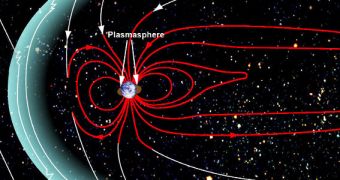Officials at NASA are proud to announce that their Time History of Events and Macroscale Interactions during Substorms (THEMIS) mission was recently able to discover a new magnetospheric process that plays an important role in keeping our planet safe from the harmful effects of solar flares, coronal mass ejections, and other particle emissions from the Sun.
Solar particles stream towards Earth and all other planets in the solar system at all times but, unlike other worlds, our own has a defensive shield it uses to block most of these particles from coming through. This role is largely fulfilled by the magnetosphere, an area of the atmosphere several hundreds of kilometers away from the surface.
This structure is permeated by magnetic field lines, which take incoming solar particles and shepherd them to the poles. This is one of the main mechanisms through which auroras are formed. THEMIS was launched on February 17, 2007 with the purpose of analyzing these intricate connections in detail.
The magnetosphere can, in essence, be likened to a giant magnetic bubble that protects our planet by interacting with solar particle streams in various ways. These interactions vary with time and other factors. Sometimes, more particles make it through, while other times, almost none do.
What THEMIS found in the new study is that dense particles flowing within Earth's magnetosphere can, on occasions, form protrusions that extend outwards towards the Sun, and meet incoming solar material head-on, essentially blocking it more effectively. How and why this process occurs is still unknown but should make for an interesting follow-up study.
“It’s like what you might do if a monster tried to break into your house. You’d stack furniture up against the front door, and that’s close to what the Earth is doing here,” explains space scientist Brian Walsh, who is based at the NASA Goddard Space Flight Center in Greenbelt, Maryland.
“The material that is usually much nearer Earth stacks up against the outer boundary of the magnetosphere, throttling the interaction there and stopping solar material from entering,” he adds.
The new study is centered around analyzing the differences between ground- and space-based observations collected during a solar storm that hit Earth on January 17, 2013. During this event, a moderate-intensity affected the magnetosphere for a few hours. Details of the work appear in the March 6 issue of the journal Science Express.
“A colleague who works with these kind of observations said I had to see some interesting data showing a plume from the ground. And I typed in the dates and saw that it was a date when THEMIS was in the right position. So, for the first time, we could make a comparison,” Walsh says.
The expert and his team found that the tongue of material extending outwards to meet the CME emissions eventually involved the entire magnetosphere in defending our planet. This would have not happened if the interactions between the solar particles and Earth's defenses would have lasted just a few minutes, the group concludes.

 14 DAY TRIAL //
14 DAY TRIAL //